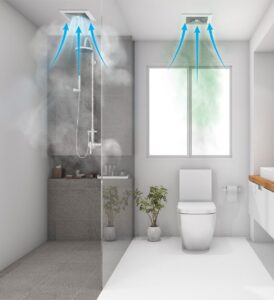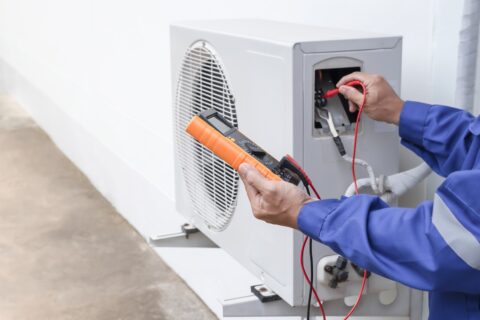Why Bathroom Ventilation is Essential
Bathroom ventilation importance cannot be overstated. Poor ventilation leads to mold, mildew, and unpleasant odors. A well-ventilated bathroom ensures fresh air circulation, promoting a healthier environment. It contrasts sharply with stuffy spaces that trap moisture, such as those with high humidity conditions and insufficient bathroom ventilation, creating health risks from humidity buildup in bathroom air.
Investing in proper ventilation systems is not just a luxury; it’s essential for any home. It prevents damage to walls and fixtures while enhancing comfort. Simple solutions like exhaust fans or windows can make a big difference. Understanding bathroom ventilation importance, hvi, helps you maintain your space effectively. Prioritize this aspect of home maintenance for long-term benefits and peace of mind.
Key Takeaways
-
Proper bathroom ventilation is essential to maintain a healthy environment and prevent issues like mold and mildew.
-
Installing a quality exhaust fan can significantly improve airflow, reducing condensation and bacteria growth.
-
Regular maintenance of your ventilation system ensures it operates efficiently and continues to protect your bathroom.
-
Avoid common mistakes, such as blocking vents or neglecting fan cleaning, to maximize the effectiveness of your ventilation.
-
Choose the right exhaust fan based on the size of your bathroom to ensure optimal performance.
-
Understanding the benefits of good airflow helps you appreciate the value of investing in proper ventilation for your home.
Understanding Bathroom Ventilation
Definition
Bathroom ventilation refers to the process of removing excess moisture and odors from the bathroom. Proper bathroom ventilation plays a crucial role in maintaining indoor air quality. It helps prevent mold growth and keeps the air fresh. Without adequate airflow, humidity can build up, leading to health issues, such as those found in a bath, and structural damage.
Types of Systems
Several types of bathroom ventilation systems exist. Common options include:
-
Exhaust Fans: These are the most popular choice. They remove humid air directly from the bathroom.
-
Window Ventilation: Opening a window allows fresh air in, moist air out, and is especially effective after a bath. This method relies on outdoor conditions.
-
Passive Ventilation: This system uses vents to allow air movement in the bath without mechanical assistance. It’s less effective in tight spaces.
Each system has its pros and cons. For example, exhaust fans provide reliable bathroom ventilation but can be noisy. Window ventilation is quiet but not always practical.
Modern Construction Impact
Modern home construction techniques often focus on energy efficiency. Many homes are built tightly sealed to save energy. This design can limit natural airflow. As a result, proper bathroom ceiling ventilation becomes even more important.
Sufficient bathroom ventilation is essential in these homes. It prevents moisture buildup in the bath that could lead to mold and mildew. Quality bathroom ventilation systems help maintain comfort and hygiene.
Selecting Bathroom Ventilation
Choosing the right bathroom ventilation fan involves several factors. Noise level is one key consideration. Silent bathroom ventilation fans operate quietly while effectively removing moisture.
Another factor is airflow capacity in the bath, measured in CFM (cubic feet per minute). A higher CFM rating means better air removal. The size of the bathroom also affects this choice. Larger bathrooms require more powerful fans.
Key Features
Reliable bathroom ventilation products should have specific features:
-
Energy Efficiency: Look for ENERGY STAR certified models to reduce electricity costs.
-
Humidity Sensors: These automatically activate the fan in the bath when moisture levels rise.
-
Light Fixtures: Some fans combine lighting with ventilation for convenience in the bath.
-
Ductless Options: These are useful where ducting isn’t possible. They filter and recirculate air instead of venting outside.
Proper bathroom ceiling ventilation ensures a healthy environment. It contributes significantly to overall home comfort.
Benefits of Proper Airflow
Humidity Control
Proper airflow in the bathroom plays a crucial role in reducing humidity levels. High humidity can lead to mold growth in the bath and damage to walls and fixtures. When air moves freely, it helps eliminate excess moisture. This is especially important after showers or baths when steam fills the room.
Using exhaust fans effectively can lower humidity quickly. Studies show that bathrooms with good ventilation can maintain humidity levels below 60%. This prevents condensation on mirrors and tiles in the bath, making the space more comfortable.
Health Impact
Good ventilation significantly impacts overall comfort and health. Stagnant air can cause discomfort and lead to respiratory issues. Poor air quality may result in headaches, fatigue, and allergies.
Air movement helps remove stale air filled with odors and pollutants. It brings in fresh air that improves breathing conditions. According to the Environmental Protection Agency (EPA), proper ventilation in the bath reduces airborne contaminants. This is vital for maintaining a healthy indoor environment.
Energy Efficiency
Effective bathroom ventilation also promotes energy efficiency. Proper airflow can reduce the need for heating or cooling systems to work harder, even in the bath. In well-ventilated bathrooms, temperature regulation becomes easier.
Installing energy-efficient exhaust fans can save money on utility bills. These fans use less electricity while still providing adequate airflow. The U.S. Department of Energy suggests using ENERGY STAR-rated products for optimal performance in the bath.
Comfort Levels
In addition to health benefits, proper airflow enhances comfort levels in the bathroom. A well-ventilated space feels fresher and more inviting. It prevents the buildup of heat and humidity that can make the bath room uncomfortable.
Ventilation systems help maintain a consistent temperature throughout the year. In winter, they prevent cold drafts from entering while allowing warm air to circulate in the bath. In summer, they reduce heat buildup, making it easier to relax in the space.
Mold Prevention
Mold thrives in damp environments. Effective ventilation minimizes this risk by keeping surfaces dry. Regularly running exhaust fans during and after baths and showers is essential for mold prevention.
The CDC emphasizes that controlling moisture is key to preventing mold growth. Homes with high humidity levels often face serious mold problems. Proper airflow directly addresses this issue by managing moisture effectively in the bath.
Preventing Mold and Mildew
Conditions for Growth
High humidity creates a perfect environment for mold and mildew in the bath. Bathrooms often have excess moisture from showers and baths. This moisture can linger, especially without proper ventilation.
Warm temperatures also contribute to mold growth. Bathrooms are usually warm after use, making it easier for mold spores to thrive. If the indoor air lacks circulation, bath humidity levels rise quickly. This combination leads to a breeding ground for harmful substances.
Role of Ventilation
Effective ventilation plays a crucial role in controlling humidity. It reduces excess moisture by allowing humid air to escape. Installing an exhaust fan in the bath can significantly improve indoor air quality.
Fans should run during and after showers. This practice helps remove steam and keeps the bathroom dry. Opening windows can also help, but this may not be practical in all homes, such as those with a bath. A certified ventilation system will ensure proper airflow throughout the space.
Regular maintenance of ventilation systems is essential. Dust and debris can build up in vents, reducing their effectiveness. Keeping these areas clean will help maintain good airflow.
Health Implications
Long-term exposure to mold can lead to serious health issues. It can cause respiratory problems, allergies, and skin irritations. People with asthma may experience worsened symptoms when exposed to mold spores.
Mold also produces mycotoxins that can affect overall health. These toxins can enter the body through inhalation or skin contact. Chronic exposure has been linked to fatigue and headaches.
Children and elderly individuals are particularly vulnerable to mold-related health risks. Their immune systems may not handle mold exposure as well as others. Preventing mold growth is vital for maintaining a safe home environment.
Reducing Condensation and Bacteria
Moisture Control
Proper ventilation in bathrooms is crucial for controlling moisture. High humidity levels often lead to condensation on surfaces like mirrors, windows, and walls. When warm, moist air meets cooler surfaces, it cools down and turns into water droplets. This process can create a damp environment that encourages the growth of mold and mildew.
Using exhaust fans helps remove this humid air quickly. Running the fan during and after showers can significantly reduce moisture levels. Keeping humidity below 60% is ideal for preventing condensation. Homeowners should ensure their ventilation systems are functioning properly to maintain a comfortable atmosphere.
Humidity Levels
Humidity levels play a significant role in bacterial growth. Bacteria thrive in warm, moist environments, making bathrooms an ideal breeding ground. Studies show that when humidity exceeds 50%, bacteria can multiply rapidly. This can lead to unpleasant odors and potential health risks.
Maintaining lower humidity levels can limit bacterial growth. Regularly using an exhaust fan or opening windows can help achieve this balance. It’s essential to monitor the bathroom’s humidity, especially during colder months when moisture tends to build up more easily.
Preventing Odors
Reducing moisture is also vital for preventing unpleasant odors in bathrooms. Stagnant water and high humidity can cause foul smells from various sources, including drains and toilets. These odors can be embarrassing and make the bathroom less inviting.
To combat this issue, proper ventilation is key. Opening windows or using exhaust fans helps circulate fresh air into the room. Keeping surfaces dry prevents odor-causing bacteria from settling in. Regular cleaning of fixtures and drains further helps maintain a fresh environment.

Summary
Effective bathroom ventilation minimizes condensation on surfaces by regulating moisture levels. High humidity conditions contribute to bacterial growth, which can lead to health issues and unpleasant odors. Proper airflow through exhaust fans or open windows reduces these risks significantly.
Choosing the Right Exhaust Fan
Key Features
Selecting a proper bathroom exhaust fan involves understanding several key features. Look for fans that have a high CFM (Cubic Feet per Minute) rating. This rating indicates how much air the fan can move. A higher CFM means better ventilation.
Consider the size of your bathroom. For small bathrooms, a fan with 50 to 100 CFM is usually sufficient. Larger bathrooms may require fans with 100 to 200 CFM or more.
Energy efficiency is another important feature. Many modern fans are ENERGY STAR rated. These fans use less electricity and can save you money on your energy bills.
Look for additional features as well. Some fans come with built-in lights or humidity sensors. Humidity sensors automatically turn the fan on when moisture levels rise. This feature helps reduce condensation and prevents mold growth.
Fan Size and Airflow Capacity
The size of the bathroom vent fan directly affects its performance. An undersized fan will struggle to remove moisture effectively. This can lead to problems like mold and mildew.
Airflow capacity, measured in CFM, plays a crucial role in ventilation effectiveness. The general rule is to choose a fan that can move at least one CFM per square foot of bathroom space. For example, if your bathroom is 100 square feet, aim for a fan with at least 100 CFM.
Consider the layout of your bathroom. If you have multiple areas that need ventilation, you may need more than one exhaust fan.
Noise Levels and Energy Efficiency
Different types of exhaust fans vary in noise levels. Some models operate quietly while others can be quite loud. Noise level is measured in sones. A lower sone rating means a quieter fan.
For example, a fan rated at 1 sone is very quiet. Fans that are rated above 4 sones can be disruptive during use. Choose a model based on your preference for sound levels.
Energy efficiency also varies among different models of bathroom fans. Look for fans that are designed to minimize energy consumption while providing strong airflow. These fans help keep energy costs low over time.
Many brands offer models that balance both quiet operation and energy efficiency. Researching options before purchasing can help find the right fit for your needs.
Installing a Ventilation System
Installation Steps
Installing a bathroom ventilation system involves several key steps. First, select the right fan based on the room size. Use the Home Ventilating Institute (HVI) guidelines to determine the ventilation rates needed for your bathroom.
Next, gather necessary tools and materials. You will need a drill, screws, ductwork, and the exhaust fan itself.
-
Turn off power to the circuit that powers the existing light fixture or switch.
-
Remove the old fixture if applicable.
-
Cut an opening in the ceiling for the new fan, ensuring it fits snugly.
-
Connect ductwork from the fan to an exterior vent.
-
Secure all components with screws.
-
Restore power and test the fan.
Proper installation ensures effective mechanical ventilation. Follow these steps carefully to avoid problems later.
Proper Placement
Placement of the ventilation system is crucial for maximum effectiveness. Install the fan near moisture sources like showers or tubs. This helps eliminate humidity quickly.
Positioning also affects airflow. Fans should be placed at least 3 feet away from any walls or obstructions. This allows air to flow freely and prevents dead spots where moisture can linger.
Consider placing the fan in line with the existing ductwork if possible. This reduces complexity and enhances efficiency.
Common Mistakes
Common installation mistakes can lead to poor performance of your ventilation system. One frequent error is underestimating the size of the fan needed. A fan that is too small won’t effectively remove moisture.
Another mistake is improper sealing of ductwork. Gaps can allow humid air to escape back into your bathroom instead of venting outside. Always use duct tape or clamps to ensure airtight connections.
Not following HVI guidelines can also result in inadequate ventilation rates. Make sure you check these standards before completing your installation.
Lastly, some people forget to connect electrical wiring correctly, which can cause safety hazards or equipment failure. Double-check all connections before restoring power.
Maintenance and Upkeep Tips
Regular Checklist
Regular maintenance is essential for bathroom ventilation systems. Homeowners should create a checklist to ensure all components function well.
-
Inspect exhaust fans every month for dust and debris.
-
Clean the fan blades at least twice a year to maintain airflow.
-
Check ducts for blockages or dirt buildup every six months.
-
Test performance ratings of the system annually to ensure efficiency.
-
Replace filters as needed, typically every three months.
This checklist helps improve the performance of ventilation systems. It also extends their lifespan, reducing the risk of deterioration.
Cleaning Importance
Cleaning exhaust fans and ducts is crucial for maintaining efficiency. Dust and grime can accumulate quickly in these areas. A dirty fan may struggle to remove moisture effectively. This can lead to mold growth and air quality issues.
Homeowners should clean the exhaust fan cover regularly. Use a damp cloth to wipe away dust. For deeper cleaning, remove the fan from the ceiling and wash it with soap and water.
Ducts also need attention. If they are clogged, they can reduce airflow significantly. Clean ducts allow better air circulation, which is vital in bathrooms where humidity levels are high.
Signs of Repair Needs
Certain signs indicate a need for repairs or replacement of ventilation systems. Homeowners should watch for these warning signals.
-
Unusual noises from the fan may suggest motor issues.
-
If the fan does not turn on, it could mean electrical problems.
-
Reduced airflow indicates possible duct blockages or fan failure.
Ignoring these signs can lead to more significant problems later on. Timely repairs can save money and ensure proper ventilation.
Additional Features
Consider adding features to enhance your bathroom ventilation system’s performance. Some products come with built-in timers or humidity sensors. These features automatically adjust operation based on moisture levels.
Investing in high-quality products ensures better performance rates over time. Look for models with good performance ratings that meet minimum requirements for your area.
In summary, maintaining bathroom ventilation systems involves regular inspections, cleaning, and being aware of signs that indicate repair needs. Following a simple checklist helps keep systems running efficiently.
Common Mistakes to Avoid
Neglecting Fans
Many homeowners forget to install or maintain fans in their bathrooms. This mistake leads to poor air circulation. Without a fan, moisture builds up after showers. High humidity can cause mold growth and damage walls.
Fans should run for at least 20 minutes after using the bathroom. This helps clear out excess moisture. Some fans have timers or humidity sensors. These features automatically turn the fan on and off.
Relying on Windows
e people think that open windows are enough for ventilation. This belief can be misleading. Windows do not provide consistent airflow, especially in winter. They can also let in cold air, which is uncomfortable.
Bathroom windows may not always be practical. In some areas, privacy is a concern. Relying solely on windows can lead to stagnant air. Stagnant air contributes to odors and dampness.
Ignoring Labels
Homeowners often overlook the label on their ventilation fans. Each fan has a specific capacity measured in cubic feet per minute (CFM). Choosing a fan with insufficient CFM can limit its effectiveness. A fan must match the size of the bathroom for optimal performance.
For example, a small bathroom needs at least 50 CFM. Larger bathrooms require more power. Always check the label before purchasing or installing a fan.
Skipping Maintenance
Regular maintenance is crucial for proper ventilation. Homeowners sometimes forget to clean their fans and ducts. Dust and debris can build up over time, reducing airflow efficiency.
Cleaning should happen at least once a year. Remove dust from the fan blades and housing. Check ducts for any blockages as well. Neglecting these tasks can lead to higher energy costs and poor air quality.
Underestimating Humidity
Humidity levels in bathrooms can rise quickly during showers. Many people underestimate how much moisture is produced. High humidity can lead to serious issues like mold and mildew.
Installing a dehumidistat can help monitor humidity levels. This device automatically activates the fan when humidity rises too high. It ensures that your bathroom remains dry and comfortable.
Closing Thoughts
Bathroom ventilation is crucial for maintaining a healthy space. Proper airflow prevents mold, reduces condensation, and keeps bacteria at bay. Choosing the right exhaust fan and ensuring regular maintenance can make a world of difference. Avoid common mistakes to maximize your system’s effectiveness.
Take action now! Assess your bathroom ventilation needs and upgrade if necessary. Your well-being depends on it. Don’t wait until mold shows up—breathe easy and enjoy a fresher home today.
Frequently Asked Questions
What is bathroom ventilation?
Bathroom ventilation is the process of circulating air in the bathroom to remove excess moisture, odors, and pollutants. It helps maintain a healthy indoor environment.
Why is proper airflow important in bathrooms?
Proper airflow prevents moisture buildup, which can lead to mold growth and structural damage. It also enhances comfort by reducing unpleasant odors.
How does bathroom ventilation prevent mold and mildew?
Effective ventilation lowers humidity levels, making it difficult for mold and mildew to thrive. This keeps your bathroom cleaner and healthier.
What are the signs of poor bathroom ventilation?
Signs include persistent odors, condensation on mirrors, peeling paint, and visible mold. If you notice these issues, it’s time to improve ventilation.
How do I choose the right exhaust fan?
Select an exhaust fan based on the bathroom size and its air exchange rate (measured in CFM). Look for energy-efficient models with low noise levels.
What maintenance does a ventilation system require?
Regularly clean the exhaust fan grill and check for obstructions in ducts. Replace filters as needed to ensure optimal performance.
What common mistakes should I avoid when ventilating my bathroom?
Avoid blocking vents, using inadequate fans, or neglecting regular maintenance. Ensure fans are used during showers and baths for effective moisture removal.


